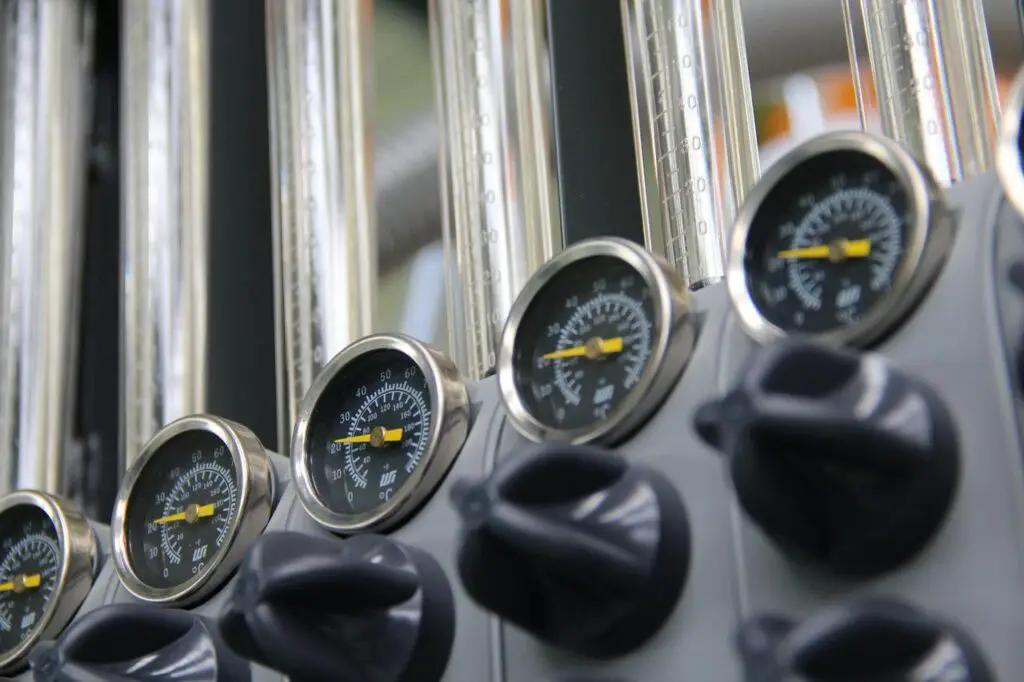CFM is a common term when dealing with an air compressor. It stands for cubic feet per minute. It tells you how much volume of air your compressor can blow in a minute. Learning how to measure the CFM of an air compressor will let you know what applications you can use the compressor for.
Contents
How to Measure the CFM of an Air Compressor
There are different ways you can go about measuring the CFM of an air compressor. To get consistent measurements, you should do the following steps:
- Find out the volume of your air compressor tank. It is usually stated in the user’s manual in gallons. If the number isn’t in gallons, convert it to gallons. You can also find it on the tank. The location depends on the manufacturers.
- Divide the volume of your tank by 7.48. This number is derived from the number of gallons in one cubic foot. The result you get is the tank’s volume converted to cubic feet.
- Make sure that your air compressor has no air by releasing it.
- Have a timer ready for timing the refill speed. Take note of the time it takes to refill the tank with air while keeping an eye on the compressor’s tank gauge. The unit you need to record is the pounds per square inch gauge (PSIG) in two different instances. The first is when the compressor starts kicking in, and the other is when the compressor stops running.
- From the numbers you got, subtract the PSIG from when the compressor started to the PSIG from when the compressor stopped running.
- Divide the difference between the two PSIG by 14.7. The result is the amount of pressure added when the tank fills the air. It is expressed in atm or atmospheric pressure.
- Use the tank’s volume (cubic feet in step 2) and multiply it by the number you get from step 6, which is the amount of pressure added during the tank filling. The product is the cubic feet your compressor filled throughout filling the tank.
- The last step would be converting the number from step 7 into minutes. Use the product you got from step 7 (cubic feet for the duration of filling the tank) and divide it by the time (seconds) it took to pump and fill the tank. Multiply the result by 60, and you get your CFM.

You solve for the following:
- Tank volume
- Standard pressure
- Cranks per minute
You multiply these together, and you get your CFM value. It’s the most popular way of calculating CFM and is relatively easy.
How CFM and PSI Relate to Each Other
Often people get confused about PSI and CFM because they are both related to pressure and air volume. For instance, if the environment is perfect, these things will happen:
When the volume is halved, the pressure is doubled; when the volume is doubled, the pressure is halved. However, such perfect conditions don’t apply to real-time. Hence, the relationship between CFM and PSI is more complicated than that.
CFM and PSI have an inverse relationship. However, you also have to factor in the changes in temperature and the change in pressure inside the compressor tank throughout the airflow.
What Are CFM and PSI?
CFM is your air compressor’s flow rate. In a more practical meaning, your compressor can stay consistent over a certain amount of time. It will determine if your compressor will need time to regulate pressure for specific tasks and to take some breaks in between.

PSI refers to the pressure of the air. PSI can gauge how well a compressor can make applications at any specified time. The PSI needs to be within the recommended amount like 100 PSI for the applications to be made properly.
Other Means to Measure CFM
There are also other ways you can measure CFM in your compressor machine. However, some might not be that accurate since some measures pressure and not CFM itself.
Manometer
A manometer is a precision instrument used to measure pressure. It is a tray filled with mercury along with a vertical vacuum-filled tube. It works by pushing air into the tray, causing the mercury to rise from a tube up to the measurement of pressure, much like how a thermometer reads.
Flow Meter
If you want to avoid calculating with numbers, the airflow meter is your friend. It is easy to measure CFM. the airflow meter measures the flow and pressure going through the compressor.
It can be easily installed on your compressor for easy reading of CFM. Where you place it also affects its accuracy. You should put it near the receiver tank for the best accuracy.
Conclusion
Measuring the CFM of an air compressor can be done in different ways. Knowing how to measure your CFM will give you an idea of the capacity of your air compressor when doing different kinds of applications.
